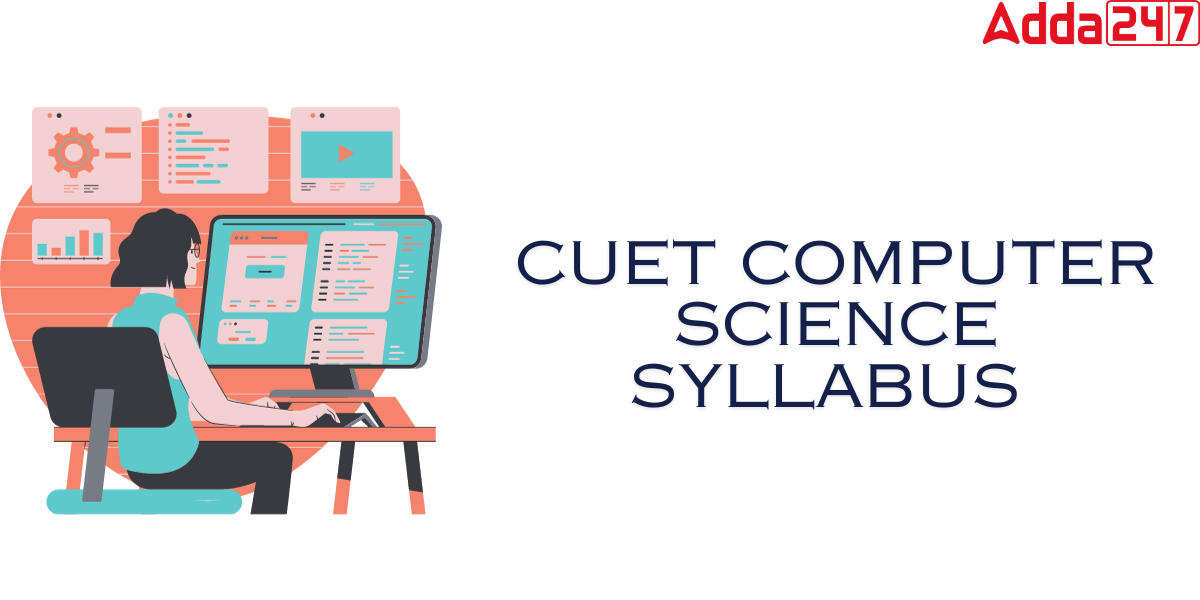In the modern era, computers and related technologies have taken the central stage. A degree in Computer Science and related field has become the path to success in today’s time. What could be more better than to pursue higher education in top institutions of India. To do so, you will have to crack the highly competitive CUET Computer Science exam. By proper guidance and full knowledge of the CUET Computer Science syllabus, one can achieve this milestone. To help budding minds, we have provided the latest CUET Computer Science syllabus 2025 in the article below.
CUET Computer Science Syllabus 2025
The National Testing Agency (NTA) has published the CUET Computer Science Syllabus 2025 for the forthcoming Common University Entrance Test. Candidates can access the CUET CS syllabus 2025 online on the official NTA CUET website at cuet.nta.nic.in. All candidates intending to choose the Computer Science option in the upcoming CUET entrance exam must examine the CUET UG Computer Science syllabus 2025 and prepare accordingly The CUET UG 2025 exam is scheduled from May 8 to June 1, 2025.
CUET CS Syllabus Overview
If you want to pursue a degree in computer science, you should be familiar with the CUET Computer Science syllabus 2025. By securing a good score, students can boost their chances of admission to the CUET-accepting university/college of their choice by learning the CUET Computer Science syllabus 2025. Check out the important information about the CUET Computer Exam Syllabus and its exam pattern.
| CUET CS Syllabus 2025 Overview | |
| Exam conducting body | National Testing Agency |
| Examination Name | Common Universities Entrance Test (CUET) |
| Year | 2025 |
| Medium of Examination | 13 Languages (English, Kannada, Hindi, Punjabi, Marathi, Tamil, Urdu, Malayalam Odia, Assamese Telugu, Bengali and Gujarati ) |
| Examination Mode | Computer-based Test (CBT) |
| Time allotted for CS Exam | 60 minutes |
| Total number of questions in the Computer section | 50 questions |
| Total Questions to be Answered | 50 questions |
| Marking Scheme | Marks per correct answer: +5 Marks per the wrong answer: -1 Marks per unanswered questions: 0 |
Also Check: CUET Topic wise General Test Syllabus 2025 PDF
CUET Computer Syllabus 2025
The CUET computer science syllabus was created to assess a candidate’s knowledge of the large and ever-changing field of computer science. The CUET syllabus for Computer Science covers a wide range of topics, including fundamental concepts such as programming languages, data structures, and algorithms. There are three components in the CUET Exam syllabus for Computer Science 2025: Section A, Section B, which have two sub-sections (B1 and B2), and Section C. The following units will be covered in the next CUET test for Computer Science.
| Unit No | Unit Name |
| A – I | Exception and File Handling in Python |
| A – II |
Database Concepts
|
| A – III |
Structured Query Language (SQL)
|
| A – IV |
Computer Networks
|
| B1 – I |
Exception and File Handling in Python
|
| B1 – II | Stack |
| B1 – III | Queue |
| B1 – IV | Searching |
| B1 – V | Sorting |
| B1 – VI |
Understanding Data
|
| B1 – VII |
Database Concepts
|
| B1 – VIII |
Structured Query Language
|
| B1 – IX |
Computer Networks
|
| B2 – I |
Database Query using SQL
|
| B2 – II |
Data Handling using Pandas – I
|
| B2 – III |
Data Handling using Pandas – II
|
| B2 – IV |
Plotting Data using Matplotlib
|
| B2 – V |
Introduction to Computer Networks
|
| B2 – VI |
Societal Impacts
|
| B2 – VII |
Data Communication
|
| B2 – VIII |
Security Aspects
|
CUET UG CS syllabus 2025 Section wise
Section A of the CUET UG Computer Science exam comprises questions that cover both Computer Science and Informatics Practices. Sections B1 and B2 each feature questions from Computer Science and Informatics Practices. Topics covered in the CUET Computer Syllabus include programming languages, data structures, and algorithms. Let’s learn more about the Sections of the CUET UG Computer Syllabus 2025.
CUET 2025 Computer Science Syllabus – Section A
Exception and File Handling in Python
Exception Handling: syntax errors, exceptions, need of exception handling, user-defined exceptions, raising exceptions, handling exceptions, catching exceptions, Try – except – else clause, Try – finally clause, recovering and continuing with finally, built-in exception classes.
File Handling: text file and binary file, file types, open and close files, reading and writing text files, reading and writing binary files using pickle module, file access modes.
Database Concepts
Introduction to database concepts, difference between database and file system, relational data
model: concept of domain, tuple, relation, keys – candidate key, primary key, alternate key, foreign
key;
Relational algebra: selection, projection, union, set difference and cartesian product;
Structured Query Language
Advantages of using Structured Query Language, Data Definition Language, Data Query Language
and Data Manipulation Language, Introduction to MySQL, Creating a database using MySQL, Data
Types
Data Definition: CREATE TABLE, DROP TABLE, ALTER TABLE,
Data Query: SELECT, FROM, WHERE
Data Manipulation: INSERT, UPDATE, DELETE
Math functions: POWER (), ROUND (), MOD ().
Text functions: UCASE ()/UPPER (), LCASE ()/LOWER (), MID ()/SUBSTRING ()/SUBSTR (),
LENGTH (), LEFT (), RIGHT (), INSTR (), LTRIM (), RTRIM (), TRIM ().
Date Functions: NOW (), DATE (), MONTH (), MONTHNAME (), YEAR (), DAY (),
DAYNAME ().
Aggregate Functions: MAX (), MIN (), AVG (), SUM (), COUNT (); using COUNT (*). Querying and manipulating data using Group by, Having, Order by.
Operations on Relations – Union, Intersection, Minus, Cartesian Product, JOIN
Computer Networks
Introduction to computer networks, Evolution of networking,
Network types: LAN, WAN, MAN
Network devices: Modem, Ethernet Card, Repeater, Hub, Switch, Router, Gateway.
Network Topologies: Mesh, Ring, Bus, Star, and Tree topologies
The basic concept of MAC and IP Address Difference between the Internet and web
CUET Computer Science Syllabus – Section B1
Section B1: Computer Science
Chapter 1: Exception and File Handling in Python
Exception Handling: syntax errors, exceptions, need for exception handling, user-defined
exceptions, raising exceptions, handling exceptions, catching exceptions, Try – except – else clause,
Try – finally clause, recovering and continuing with finally, built-in exception classes.
File Handling: text file and binary file, file types, open and close files, reading and writing text
files, reading and writing binary files using the pickle module, and file access modes.
Chapter 2: Stack
Stack (List Implementation): Introduction to stack (LIFO Operations), operations on stack (PUSH
and POP) and its implementation in python. Expressions in Prefix, Infix and postfix notations,
evaluating arithmetic expressions using stack, conversion of Infix expression to postfix
expression
Chapter 3: Queue
Queue (List Implementation): Introduction to Queue (FIFO), Operations on Queue (INSERT and
DELETE) and its implementation in Python.
Introduction to DQueue and its implementation in Python.
Chapter 4: Searching
Searching: Sequential search, Binary search, Analysis of Sequential and Binary Search. Dry run to
identify best, worst and average cases. Implementation of searching techniques in Python.
Chapter 5: Sorting
Overview of sorting techniques, Bubble Sort, Selection Sort and Insertion Sort. Dry run to identify
best, worst and average cases. Implementation of sorting techniques in Python.
Hashing: Hash Functions, Collision Resolution, Implementing the Map Abstract Data Type.
Chapter 6: Understanding Data
Data and its purpose, collection, and organization; understanding data using statistical methods:
mean, median, standard deviation, variance; data interpretation; visualization of data.
Chapter 7: Database Concepts
Introduction to database concepts, the difference between database and file system, relational data
model: concept of the domain, tuple, relation, keys – candidate key, primary key, alternate key,
foreign key;
Relational algebra: selection, projection, union, set difference and cartesian product;
Chapter 8: Structured Query Language
Advantages of using Structured Query Language, Data Definition Language, Data Query
Language and Data Manipulation Language, Introduction to MySQL, Creating a database using
MySQL, Data Types
Data Definition: CREATE TABLE, DROP TABLE, ALTER TABLE,
Data Query: SELECT, FROM, WHERE
Data Manipulation: INSERT, UPDATE, DELETE
Math functions: POWER (), ROUND (), MOD ().
Text functions: UCASE ()/UPPER (), LCASE ()/LOWER (), MID ()/SUBSTRING ()/SUBSTR (),
LENGTH (), LEFT (), RIGHT (), INSTR (), LTRIM (), RTRIM (), TRIM ().
Date Functions: NOW (), DATE (), MONTH (), MONTHNAME (), YEAR (), DAY (), DAYNAME ().
Aggregate Functions: MAX (), MIN (), AVG (), SUM (), COUNT (); using COUNT
(*). Querying and manipulating data using Group by, Having, Order by.
Operations on Relations – Union, Intersection, Minus, Cartesian Product, JOIN
Chapter 9: Computer Networks
Introduction to computer networks, Evolution of networking,
Network types: LAN, WAN, MAN
Network devices: Modem, Ethernet Card, Repeater, Hub, Switch, Router, Gateway.
Network Topologies: Mesh, Ring, Bus, Star, and Tree topologies
Basic concept of MAC and IP Address
Difference between Internet and web
CUET Informatics Practices Syllabus 2025 Section B2
Section B2: Informatics Practices
Chapter 1: Database Query using SQL
Math functions: POWER (), ROUND (), MOD ().
Text functions: UCASE ()/UPPER (), LCASE ()/LOWER (), MID ()/SUBSTRING
()/SUBSTR (),LENGTH (), LEFT (), RIGHT (), INSTR (), LTRIM (), RTRIM (), TRIM ().
Date Functions: NOW (), DATE (), MONTH (), MONTHNAME (), YEAR (), DAY (), DAYNAME ().
Aggregate Functions: MAX (), MIN (), AVG (), SUM (), COUNT (); using COUNT (*).Querying and manipulating data using Group by, Having, Order by.
Operations on Relations – Union, Intersection, Minus, Cartesian Product, JOIN
Chapter 2: Data Handling using Pandas – I
Introduction to Python libraries- Pandas, NumPy, Matplotlib. Data structures in Pandas – Series and
DataFrames.
Series: Creation of Series from – and array, dictionary, scalar value; mathematical operations;
Head and Tail functions; Selection, Indexing, and Slicing.
DataFrames: creation – from the dictionary of Series, list of dictionaries, Text/CSV files; display;
iteration; Operations on Rows and columns: add, select, delete, rename; Head and Tail functions;
Indexing using labels, Boolean Indexing; Styling & Formatting data, Head and Tail functions;
Joining, Merging, and Concatenations.
Importing/Exporting Data between CSV files and DataFrames.
Chapter 3: Data Handling using Pandas – II
Descriptive Statistics: max, min, count, sum, mean, median, mode, quartile, Standard deviation,
variance.
DataFrame operations: Aggregation, group by, Sorting, Deleting and Renaming Index, Pivoting.
Handling missing values – dropping and filling.
Importing/Exporting Data between MySQL database and Pandas.
Chapter 4: Plotting Data using Matplotlib
Purpose of plotting; drawing and saving the following types of plots using Matplotlib – line
plot, bargraph, histogram, pie chart, frequency polygon, box plot, and scatter plot.
Customizing plots: color, style (dashed, dotted), width; adding label, title, and legend in plots.
Chapter 5: Introduction to Computer Networks
Introduction to Networks, Types of networks: LAN, MAN, WAN.
Network Devices: modem, hub, switch, repeater, router, gateway
Network Topologies: Star, Bus, Tree, Mesh.
Introduction to Internet, URL, WWW, and its applications- Web, email, Chat, VoIP.
Website: Introduction, the difference between a website and webpage, static vs dynamic web
page, webserver, and hosting of a website.
Web Browsers: Introduction, commonly used browsers, browser settings, add-ons and plugins, cookies.
Chapter 6: Societal Impacts
Digital footprint, Etiquettes for Net surfing and for communicating through social media, data
protection, Intellectual Property Rights (IPR) and their violation, plagiarism licensing and copyrights, Free and Open Source Software (FOSS), Cybercrime and cyber laws, hacking, phishing, cyberbullying, Overview of Indian IT Act, preventing cybercrime.
E-waste its a hazard and management
Awareness about health concerns related to the usage of technology like effect on eyesight, physiological issues, and ergonomic aspects.
Chapter 7: Data Communication
Concept of communication, Types of Data Communication, switching techniques
Communication Media: Wired Technologies – Twisted pair cable, Co-axial cable, Ethernet
Cable, Optical Fibre;
Introduction to mobile telecommunication technologies Wireless Technologies – Bluetooth, WLAN, Infrared, Microwave
Network Protocol: Need for Protocol, Categorization and Examples of protocol, HTTP, FTP, IP,
PPP; electronic mail protocol
Concept of Channel, Bandwidth (Hz, KHz, MHz) and Data Transfer rate (bps, Kbps, Mbps, Gbps,
Tbps)
Chapter 8: Security Aspects
Threats and prevention: Viruses, Worms, Trojan horses, Spam, Cookies, Adware, Firewall, http vs
https
Network Security Concepts: Firewall, Cookies, Hackers and Crackers
Antivirus and their workings
Network security threats: Denial of service, Intrusion problems, Snooping, Eavesdropping
CUET Previous Year Question Paper
CUET Computer Science Practices Syllabus 2025 PDF Download
CUET Computer Science Syllabus 2025 can be downloaded from the official portal. Candidates taking CUET 2025 must have a thorough understanding of the CUET computer science syllabus. Candidates can access the CUET UG 2025 Computer Science Syllabus pdf by clicking on the link provided below.
Computer Science Syllabus for CUET – Books
It is critical to select the appropriate study materials for the CUET Computer Science exam 2025. NCERTs are widely regarded as the top resources for the CUET computer science curriculum. There are, however, other books that can help with preparation. The following are some popular books that cover the Computer Science Syllabus for CUET
- Class XI and XII Computer Science NCERT Textbook by NCERT
- In conjunction with Rachna Sagar’s Computer Science Class 12
- Computer Awareness by Arihant Experts
- Sumita Arora’s Computer Science with Python Class 12
- Go To Guide for CUET (UG) Computer Science/ Informatics Practices with 2022 Previous
- Question Papers- Disha Experts
Importance of CUET UG Computer Science Syllabus 2025
The CUET computer science syllabus has been designed to measure a candidate’s skill in the vast and ever-changing subject of Computer Science. Understanding the CUET computer science syllabus 2025 is essential for individuals interested in pursuing higher education in the Computer Science domain. The CUET UG 2025 examination seeks to identify the most capable candidates for undergraduate studies in Computer Science at India’s top Computer Science colleges. CUET aspirants in addition to the General CUET Syllabus 2025, must thoroughly learn the CUET Computer Syllabus before beginning the full phase of CUET preparation.










 DU CSAS Portal UG 2025 @admission.uod.ac...
DU CSAS Portal UG 2025 @admission.uod.ac...
 CUET Cut Off 2025: DU, BHU, JNU, Jamia Q...
CUET Cut Off 2025: DU, BHU, JNU, Jamia Q...
 How To Prepare for CUET Accountancy Exam...
How To Prepare for CUET Accountancy Exam...


